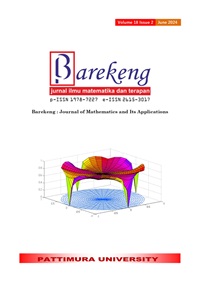ANALYSIS AND OPTIMAL CONTROL OF TUBERCULOSIS DISEASE SPREAD MODEL WITH VACCINATION AND CASE FINDING CONTROL (CASE STUDY: SURABAYA CITY)
Abstract
Tuberculosis is a contagious disease that infects humans. It is caused by the bacterium Mycobacterium tuberculosis (M.tb). It is the largest infectious disease in the world and has become a major global health problem. Therefore, efforts are being made to control the spread of tuberculosis disease through vaccination and case finding, with the aim of reducing the population of latently infected and actively infected individuals. This study discusses the mathematical model of tuberculosis disease spread, disease-free and endemic equilibrium points, and stability analysis around the equilibrium points. Then, using Pontryagin's minimum principle, the optimal control problem is solved numerically by the 4th-order Runge-Kutta method. Based on the analysis and simulation results, the system is asymptotically stable around the disease-free and endemic equilibrium points. Furthermore, optimal control in the form of vaccination of susceptible individuals is required to further suppress the rate of change of susceptible individuals into latent individuals, while control in the form of case finding on latently infected individuals is required until the 9th year to minimize the population size, while on actively infected individuals, it is required until the 8th year to minimize the population size. Providing optimal control resulted in a 100% increase in the susceptible population and a 100% reduction in the latent and infected populations.
Downloads
References
A. F. Ismoilovich. “Tuberculosis Diagnostics with Modern Solutions (Literature Review),” Central Asian Journal of Medical and Natural Science, vol. 3, no. 3, pp. 377-383, 2022.
World Health Organization., Global tuberculosis report 2020. World Health Organization, 2020.
Rokom, “Deteksi TBC Capai Rekor Tertinggi di Tahun 2022,” Sehat Negeriku, 31 March 2023. [Online]. Available: https://sehatnegeriku.kemkes.go.id/baca/rilis-media/20230331/3942688/deteksi-tbc-capai-rekor-tertinggi-di-tahun-2022/ [Access on 21 October 2023].
D. E. Kirk, Optimal Control Theory: An Introduction. Courier Corporation, 2004.
S. Kim, A. A. de los Reyes, and E. Jung, “Mathematical Model and Intervention Strategies for Mitigating Tuberculosis in the Philippines,” Journal of Theoretical Biology, vol. 443, pp. 100–112, April 2018.
S. Ullah, M. A. Khan, and M. Farooq, “A Fractional Model for The Dynamics of TB Virus,” Chaos, Solitons and Fractals, vol. 116, pp. 63–71, November 2018.
Z. U. A. Zafar, S. Zaib, M. T. Hussain, C. Tunç, and S. Javeed, “Analysis and Numerical Simulation of Tuberculosis Model using Different Fractional Derivatives,” Chaos, Solitons and Fractals, vol. 160, July 2022.
M. Yavuz, F. Özköse, M. Akman, and Z. T. Taştan, “A New Mathematical Model for Tuberculosis Epidemic under the Consciousness Effect,” Mathematical Modelling and Control, vol. 3, no. 2, pp. 88–103, 2023.
D. P. Gao and N. J. Huang, “Optimal Control Analysis of a Tuberculosis Model,” Applied Mathematical Model, vol. 58, pp. 47–64, June 2018.
S. F. Abimbade, S. Olaniyi, O. A. Ajala, and M. O. Ibrahim, “Optimal Control Analysis of a Tuberculosis Model with Exogenous Re-infection and Incomplete Treatment,” Optimal Control Applied Methods, vol. 41, no. 6, pp. 2349–2368, November 2020.
N. Inayah, M. Manaqib, N. Fitriyati, and I. Yupinto, “Mathematical Models of Spread Pulmonary Turberculosis Disease with Use of Medical Mask,” BAREKENG: Jurnal Ilmu Matematika dan Terapan, vol. 14, p. 3, 2020.
M. M. Ojo, O. J. Peter, E. F. D. Goufo, H. S. Panigoro, and F. A. Oguntolu, “Mathematical Model for Control of Tuberculosis Epidemiology,” Journal of Applied Mathematics and Computing, vol. 69, no. 1, pp. 69–87, Ferbruary. 2023.
G. M. Knight et al., “Impact and Cost-Effectiveness of New Tuberculosis Vaccines in Low- and Middle-Income Countries,” in Proc. National Academy of Sciences USA, vol. 111, no. 43, pp. 15520–15525, October 2014.
Subiono, “Sistem Linear dan Kontrol Optimal,” Surabaya: Jurusan Matematika FMIPA-ITS, 2013.
P. Saraswati, Mardlijah, Kamiran. “Analisis dan Kontrol Optimal Sistem Gerak Satelit Menggunakan Prinsip Minimum Pontryagin”. Jurnal Sains dan Seni ITS, Vol. 6 No. 2, A45-A50, 2017.
D. S. Naidu, Optimal control systems. CRC Press, 2003.
Copyright (c) 2024 Dinda Anisa' Maulina, Chairul Imron

This work is licensed under a Creative Commons Attribution-ShareAlike 4.0 International License.
Authors who publish with this Journal agree to the following terms:
- Author retain copyright and grant the journal right of first publication with the work simultaneously licensed under a creative commons attribution license that allow others to share the work within an acknowledgement of the work’s authorship and initial publication of this journal.
- Authors are able to enter into separate, additional contractual arrangement for the non-exclusive distribution of the journal’s published version of the work (e.g. acknowledgement of its initial publication in this journal).
- Authors are permitted and encouraged to post their work online (e.g. in institutional repositories or on their websites) prior to and during the submission process, as it can lead to productive exchanges, as well as earlier and greater citation of published works.






1.gif)



